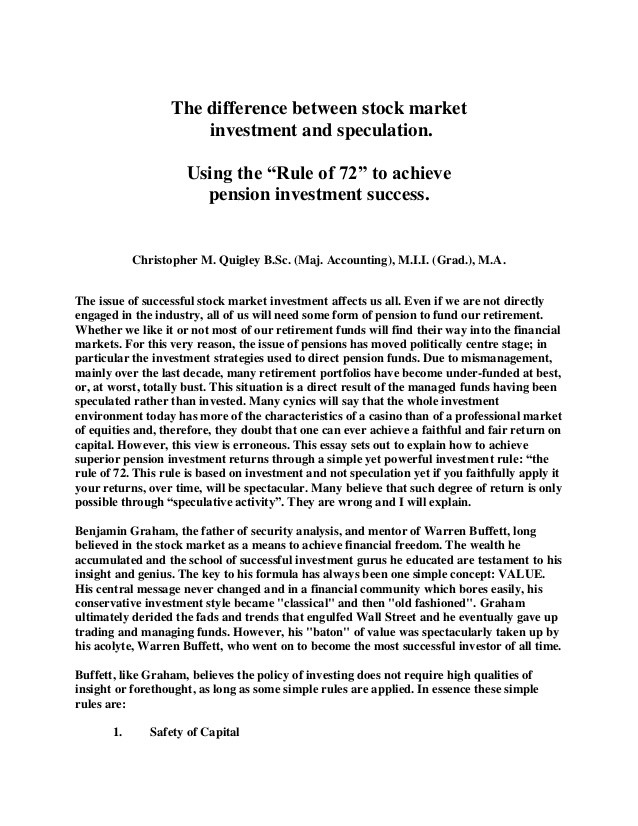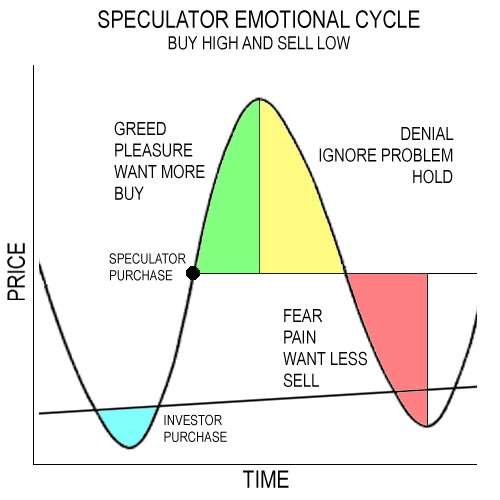What Is the Difference between Investing and Speculation
Post on: 30 Июнь, 2015 No Comment

Editors note: Today, we are doing something different. Robert approached us with a question that we found interesting, so we decided to pose it to some professional investors. In addition to our regular coverage, we are pleased to feature his framing of an interesting debate. We will be publishing select responses to the question over the next few days. If you are compelled, we invite you to comment below, tweet us @cfainvestored, or reach out to us via email .
What is the difference between investing and speculation? At first, you think the answer is simple because the distinction is obvious — that is, until you actually put pen to paper and try to answer the question.
Go ahead; take a few seconds and think about it. Write down “investing.” Now write the definition. Do the same for “speculation.” If you are like me, frustration quickly builds because the answers do not come quickly or easily, and they should. After all, these terms have been a part of the financial lexicon since Joseph de la Vega wrote Confusion of Confusions in 1688, the oldest book ever written on the stock exchange business. In his famous dialogues, de la Vega observed three classes of men. The princes of business, called “financial lords,” were the wealthy investors. The merchants, the occasional speculators, were the second class. The last class was called the “persistent speculators” or the “gamblers.”
Since the Dutch shipping firm Vereenigde Oost-Indische became the first company to trade its shares on the Amsterdam Stock Exchange, investors and speculators have coexisted in the marketplace. Over that 400-year time period, the noteworthy have offered their own definitions of investing and speculation. But none have stuck.
Philip Carret, who wrote The Art of Speculation (1930), believed “motive” was the test for determining the difference between investment and speculation. “The man who bought United States Steel at 60 in 1915 in anticipation of selling at a profit is a speculator. On the other hand, the gentleman who bought American Telephone at 95 in 1921 to enjoy the dividend return of better than 8% is an investor.” Carret connected the investor to the economics of the business and the speculator to price. “Speculation,” wrote Carret, “may be defined as the purchase or sale of securities or commodities in expectation of profiting by fluctuations in their prices.”
Benjamin Graham, along with David Dodd, attempted a precise definition of investing and speculation in their seminal work Security Analysis (1934). “An investment operation is one which, upon thorough analysis, promises safety of principal and a satisfactory return. Operations not meeting these requirements are speculative.” Despite being the “dean of security analysis,” Graham’s definition left readers wanting more — a fact he confessed years later when he wrote The Intelligent Investor (1949). “While we have clung tenaciously to this definition,” said Graham, “it is worthwhile noting the radical changes that have occurred in the use of the term ‘investor’ during this period.”
Graham was concerned that the term “investor” was now being applied ubiquitously to anyone and everyone who participated in the stock market. He explained: “The newspaper employed the word ‘investor’ in these instances because, in the easy language of Wall Street, everyone who buys or sells a security has become an investor, regardless of what he buys, or for what purpose, or at what price, or whether for cash or on margin.” Graham went on to say: “Since there is no single definition of investment in general acceptance, authorities have the right to define it pretty much as they please. Many of them deny that there is any useful or dependable difference between the concepts of investment and of speculation. We think this skepticism is unnecessary and harmful. It is injurious because it lends encouragement to the innate leaning of many people toward the excitement and hazards of stock-market speculation.”
John Maynard Keynes, best known as one of the founders of modern macroeconomics and thought to be the most influential economist of the 20th century, was also a skilled buyer and seller of stocks, bonds, commodities, and currencies. In addition to thinking about economics, he was intrigued with the stock market. Tucked inside his magnum opus, The General Theory of Employment, Interest, and Money (1936), is a chapter titled “The State of Long Term Expectation.” Here, Keynes got right to the point, deciding to “appropriate the term speculation for the activity of forecasting the psychology of the market, and the term enterprise [a word he used for investment] for the activity of forecasting the prospective yield of assets over their whole life.” But the breadth of the chapter has less to do with the difficulty of defining investment and speculation and more to do with the observation that the lines between the two approaches had blurred. It is the same point that is driven home 75 years later in The Clash of the Cultures: Investment vs. Speculation (2012). In his book, John Bogle argued that in the minds of most individuals, investment and speculation are now indistinguishable.
All market activity lies on a time continuum. Moving from left to right, we observe buy–sell decisions in the stock market that occur in microseconds, minutes, hours, days, weeks, months, years, and decades. Although it is unclear exactly where the demarcation line is located, it is generally agreed that activity occurring on the left side of the time continuum is more likely to be speculation, whereas activity residing on the right side is thought to be investing. In Bogle’s opinion, investment means long-term ownership whereas speculation is more short-term trading. Carret concurred, writing: “The time requisite for the accomplishment of the adjustment of prices to values is a factor of great weight to the speculator. Here he parts company with the investor, to whom it is of little concern.”
Thinking long term or short term might be a sensible starting point that helps us distinguish between investing and speculation. But a “stopwatch” definition leaves us woefully short of what is ultimately needed to better understand the differences between these two approaches. A time element is simply not sufficient. The distinction between investment and speculation is more complex than this.
Let me be clear: This not a sneaky attempt to demonize speculation and declare that only investing is sacrosanct. Academic research clearly demonstrates that the market benefits from, and is optimized by, the participation of both investors and speculators. Although some investment purists might vote for opening the stock market just one day each year and on that day all buyers and sellers would transact business, the lack of daily liquidity would likely do more harm than good for the capital markets. Furthermore, despite its negative connotation, it can be argued that some types of speculation are, in fact, socially redeeming. Lynn Stout, Distinguished Professor of Corporate and Business Law at Cornell Law School, in “Uncertainty, Dangerous Optimism, and Speculation: An Inquiry into Some Limits of Democratic Governance” argued that a speculator that provides insurance and liquidity for the risk-averse farmer who wishes to enter into a forward contract to sell his wheat at today’s price deliverable next month “fits the standard economic model of mutually beneficial exchange that improves the welfare of both trading parties.”

In addition to risk hedging and liquidity dealing, Milton Friedman told us that speculators who practice what is today called “information theory arbitrage” should be thought of as talented researchers who work aggressively to close the price–value gap. Carret shared the same opinion. He wrote: “The speculator is looking for hidden weak spots in the market,” and as such, acts as “the advance agent of the investor, seeking always to bring market prices into line with investment values.”
Even Graham in The Intelligent Investor came to accept the necessity of speculation. “Outright speculation is neither immoral, nor (for most people) fattening to the pocketbook. More than that, some speculation is necessary and unavoidable.” But Graham was quick to distinguish between “good” and “bad” speculation. “There is intelligent speculation as there is intelligent investing. But there are many ways in which speculation may be unintelligent,” wrote Graham.
But how can we distinguish between what is “good speculation” and “bad speculation,” or “good investment” and “bad investment” for that matter, when we don’t even have a firm grasp of the basic definitions? Lacking clearly understood boundaries, individuals are wandering aimlessly back and forth between the worlds of investing and speculation. And herein lies the danger. The stock market is now dominated by a newly evolved species, the investulator — defined as an investor who unwittingly acquires speculative habits without realizing it. Although more study is needed, it is highly possible being an investulator is the reason why so many individuals perform badly in the stock market.
There is a very important passage in Graham’s The Intelligent Investor. Graham wrote: “The distinction between investment and speculation in common stocks has always been a useful one and its disappearance is a cause for concern. We have often said that Wall Street as an institution would be well advised to reinstate this distinction and to emphasize it in all its dealings with the public. Otherwise the stock exchanges may some day be blamed for heavy speculative losses, which those who suffered them had not been properly warned against.” True today as it was 60 years ago.
So, let’s begin. What is the definition of investing? What is the definition of speculation?
If you liked this post, dont forget to subscribe to Inside Investing via Email or RSS.
Please note that the content of this site should not be construed as investment advice, nor do the opinions expressed necessarily reflect the views of CFA Institute.














